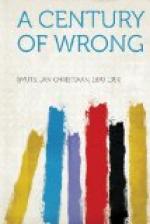Full of hope we said to ourselves if only the Queen of England and the English people knew that in the Transvaal a people were being oppressed, they would never suffer it.
[Sidenote: The War of Freedom.]
But we had now to admit that it was of no use appealing to England, because there was no one to hear us. Trusting in the Almighty God of righteousness and justice, we armed ourselves for an apparently hopeless struggle in the firm conviction that whether we conquered or whether we died, the sun of freedom in South Africa would arise out of the morning mists. With God’s all-powerful aid we gained the victory, and for a time at least it seemed as if our liberty was secure.
At Bronkorst Spruit, at Laing’s Nek, at Ingogo, and at Majuba, God gave us victory, although in each case the British troopers outnumbered us, and were more powerfully armed than ourselves.
After these victories had given new force to our arguments, the British Government, under the leadership of Gladstone, a man whom we shall never forget, decided to cancel the Annexation, and to restore to us our violated rights.
FOOTNOTES:
[Footnote 23: Molesworth.]
[Footnote 24: Theal, 305.]
[Footnote 25: 30th April, 1877, Letter to the Rev. La Touche.]
[Footnote 26: Martineau, The Transvaal Trouble, page 76.]
[Footnote 27: Martineau, The Transvaal Trouble, page 69.]
[Footnote 28: The Transvaal Trouble, page 76.]
CONVENTIONS OF 1881 AND 1884.
[Sidenote: Pretoria Convention.]
An ordinary person would have thought that the only upright way of carrying a policy of restitution into effect would have been for the British Government to have returned to the provisions of the Sand River Convention. If the Annexation was wrong in itself—without taking the Boer victories into consideration—then it ought to have been abolished with all its consequences, and there ought to have been a restitutio in integrum of that Republic; that is to say, the Boers ought to have been placed in exactly the same position as they were in before the Annexation. But what happened? With a magnanimity which the English press and English orators are never tired of vaunting, they gave us back our country, but the violation of the Sand River Convention remained unredressed. Instead of a sovereign freedom, we obtained free internal administration, subject to the suzerain power of Her Majesty over the Republic. This occurred by virtue of the Convention of Pretoria, the preamble of which bestowed self-government on the Transvaal State with the express reservation of suzerainty. The articles of that Convention endeavoured to establish a modus vivendi between such self-government and the aforesaid suzerainty. Under this bi-lateral arrangement the Republic was governed for three years by two heterogeneous principles—that of representative self-government, and that represented by the British Agent. This system was naturally unworkable; it was also clear that the arrangement of 1881 was not to be considered as final.




